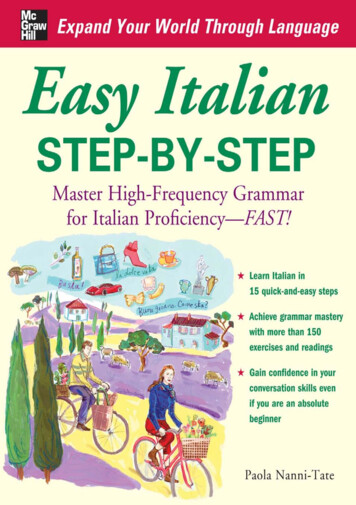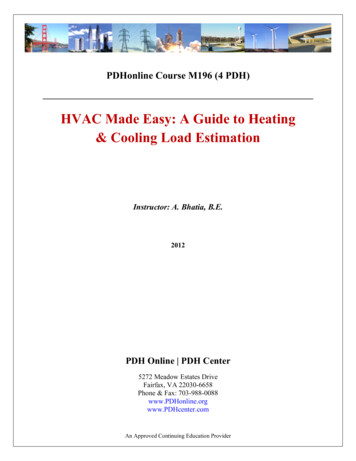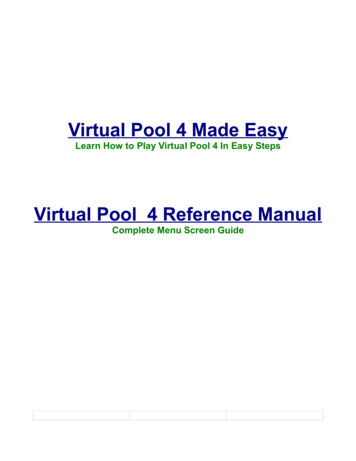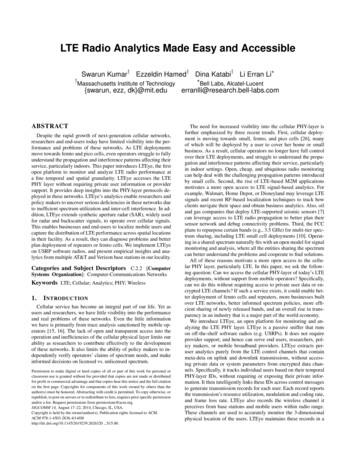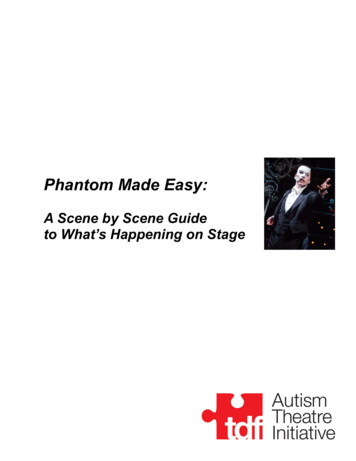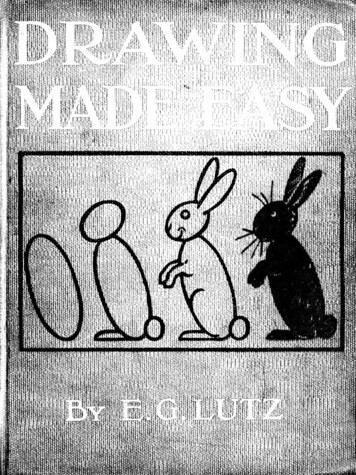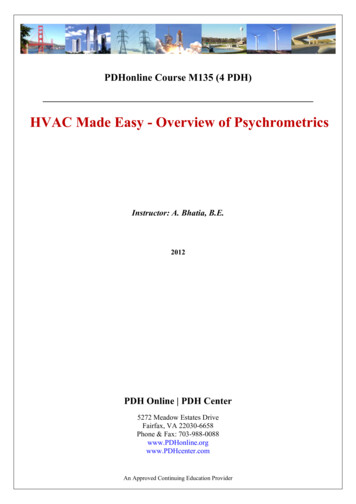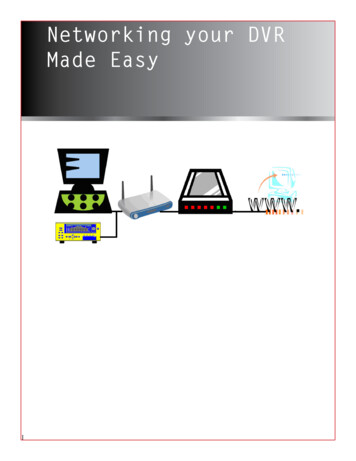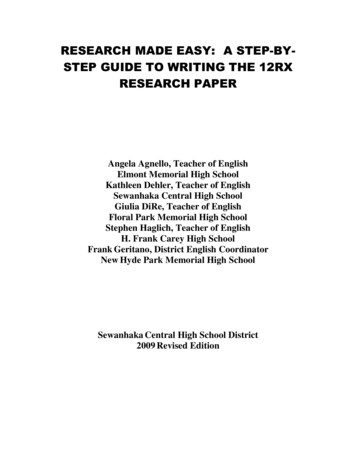
Transcription
RESEARCH MADE EASY: A STEP-BYSTEP GUIDE TO WRITING THE 12RXRESEARCH PAPERAngela Agnello, Teacher of EnglishElmont Memorial High SchoolKathleen Dehler, Teacher of EnglishSewanhaka Central High SchoolGiulia DiRe, Teacher of EnglishFloral Park Memorial High SchoolStephen Haglich, Teacher of EnglishH. Frank Carey High SchoolFrank Geritano, District English CoordinatorNew Hyde Park Memorial High SchoolSewanhaka Central High School District2009 Revised Edition
RATIONALEResearch Made Easy: A Step-by-Step Guide to Writing the 12RX Research Paper isdesigned primarily to be utilized by students in senior high school who are writing aresearch paper. The purpose of this guide is twofold: to give students a sequentialapproach to writing the research paper from selecting a topic, doing the research,organizing the materials, and producing the finished document, and to readily preparestudents to meet the demands and rigors of college writing and research. Sample termpapers, along with alternative assessments and exercises are included to engage alllearners.i
ACKNOWLEDGEMENTThe collaborators of Research Made Easy: A Step-by-Step Guide to Writing the12RX Research Paper would like to recognize and thank the following individualsfor their assistance and support:Mr. Warren Meierdiercks, Superintendent of SchoolsDr. Linda Opyr, Assistant Superintendent forCurriculum and InstructionMr. Frank Geritano, District English CoordinatorMs. Karen Annunziata, District Library MediaCoordinatorii
STANDARDS AND INDICATORSThe following New York State Standards and Performance Indicators were utilized whendesigning the revised 2009 edition of the Research Guide:READINGStandard I: Students will read, write, listen, and speakfor information and understanding.12.R.001 – Locate and use school, public, academic, andspecial library resources for information andresearch.--use primary and secondary sources, such asdictionaries and abstracts--set purpose for reading by asking questionsabout what they need to know for theirresearch12.R.002 – Check consistency of hypothesis with giveninformation and assumption.12.R.003 – Analyze and synthesize information fromdifferent sources by making connections andshowing relationships to other texts, ideas,subjects, and the world at large.Standard II: Students will read, write, listen, and speakfor literary response and expression.12.R.005 – Read, view, and respond independently toliterary works that represent a range of social, historical, and culturalperspectives.12.R. 008 – Read and interpret literary texts from arange of authors, genres, and subjectsincluding literary criticism.12.R. 009 – Interpret multiple levels of meaning andsubtleties in text.iii
Standard III: Students will read, write, listen, and speakfor critical analysis and evaluation.12.R.010 – Analyze and evaluate non-fiction texts,including professional journals, technicalmanuals, and position papers to determinethe writer‘s perspectives, purposes, andintended audience.12.R.013 – Form opinions and make judgments aboutliterary works by analyzing and evaluatingtexts from more than one criticalperspective, such as a social perspective.12.R.015 – Make judgments about the quality of literarytexts and performances by applying personaland academic criteria, such as that found inliterary criticism.12.R.016 – Analyze and evaluate the intellectual and/oremotional impact of specific texts on thereader.Standard IV: Students will read, write, listen, and speakfor social interaction.12.R. 018 – Consider the age, gender, social position,and cultural traditions of the writer.12.R. 019 – Understand and anticipate the author‘s useof tone, diction, and language appropriateto social communication in a variety of textsand conventions.12.R.020 – Recognize the types of language (e.g.informal vocabulary, culture-specificterminology, jargon, colloquialisms, andemail conventions) that are appropriate tosocial communication.iv
WRITINGStandard I: Students will read, write, listen, and speakfor information and understanding.12.W.001 – Use and integrate a wide range oforganizational strategies to presentinformation.12.W.002 – Define the meaning of and understand theconsequences of plagiarism; investigatecollege and university policies.Standard II: Students will read, write, listen, and speakfor literary response and expression.12.W.005 – Use resources such as personal experience,knowledge from other content areas, andindependent reading to create literary,interpretive, and responsive text.Standard III: Students will read, write, listen, and speakfor critical analysis and evaluation.12.W.007 – Develop critiques from more than one perspective, such as historical,cultural, social, and psychological.LISTENINGStandard II: Students will read, write, listen, and speakfor literary response and expression.12.L.003 – Interpret and respond to texts from a varietyof genres, authors and subjects.Standard III: Students will read, write, listen, and speakfor critical analysis and evaluation.12.L.007 – Determine points of view to clarify positions,make judgments and form opinions.v
12.L.009 – Evaluate the expertise and possible bias ofthe speaker in order to judge the validity of the content.SPEAKINGStandard III: Students will read, write, listen, and speakfor critical analysis and evaluation.12.S.004 – Express opinions and make judgments aboutideas, information, experiences, and issues inliterary, scientific, and historical articles, inpublic documents and in advertisements.12.S.005: Present reasons, examples, and details from sources .to defend opinions orjudgments.12.S.006 – Respond to constructive criticism.vi
Guidelines for Writing and Grading the Research PaperEvery senior, according to the mandates of the Sewanhaka Central High School District,must complete and pass a research paper in English in order to graduate. The researchpaper in English 12AP must be completed by the end of the third quarter and theresearch paper in English 12RX must be completed in the first semester.The following guidelines must be adhered to when writing and grading the researchpaper: The length of the research paper must be no less than six pages, with the WorksCited page counting as one page. The research paper must follow the current MLA format and guidelines to pass. The research paper may be literary or non-literary based upon the decision ofeach school. Each component of the research paper, as seen in the suggested timeline onpage 1, will be assigned a grade and each component will then become part ofthe research paper‘s culminating final grade. **Keep in mind that thecomponents being graded and the grades assigned to those components mustbe agreed upon and followed by all 12RX and 12AP teachers in each school. Papers submitted after the official due date will have five (5) points deductedfrom the grade received each day the paper is late. **In fairness to all students,no exceptions will be made to this rule unless there are unforeseen emergenciesthat require a doctor‘s note or some type of valid documentation which warrantssuch an event or situation. Printers running out of ink, oversleeping when theresearch paper is due, or computers crashing DOES NOT count as unforeseenemergencies. Always prepare for the unexpected: frequently back up yourpaper as you type, print copies of your paper, and ensure that your printer hasenough ink before beginning to type your papervii
TABLE OF CONTENTSRationale .iAcknowledgement iiStandards and Indicators iii-viGuidelines for Writing and Grading the Research Paper .viiIntroduction 1Step 1: Selecting a Topic .2Step 2: Research Your Topic 3-12Step 3: Develop a Thesis .13-14Step 4: Organize Your Material 15-19Step 5: Rough Draft With In-Text Citation .20-21Step 6: Checklist For Revising the Rough Draft 22Step 7: Organize the Works Cited Page .23-28Appendix 29Turnitin.com .30-31Bibliography and Note Cards Practice Activity 32-33Checklist For Assessing Bibliography and Note Cards .34Thesis Writing Activity Using Sample Note Cards .35Outlining Activity For the Non-Literary Research Paper .36-37Sample Non-Literary Term Paper .38-43Sample Literary Term Paper 44-49Identifying Thesis Statement Activity .50Alternative Note Card Worksheet 51
INTRODUCTIONWHAT IS A RESEARCH PAPER?A research paper is a document in which you prove or defend a thesis with the opinions,ideas, facts, and/or statements of others.WHAT IS A THESIS?A thesis is a statement that can be proved. Do not confuse a thesis with a fact. Forexample: The families of Romeo and Juliet were enemies. This is a fact about Shakespeare‘splay. A thesis could be: Friar Laurence is often portrayed as a bumbling fool; however, he isreally a wise man trapped by the same forces as his two impulsive lovers.HOW DO YOU WRITE A RESEARCH PAPER?Follow these 8 suggested steps when writing a research paper:(This is a suggested time line.)1. Select a topic.(Start 2 months before due date)2. Research your topic.(4 weeks)3. Develop a thesis.(1 week)4. Organize your material.5. Write a rough draft.(1 week)6. Organize Works Cited page.7. Type, proofread, and correct.(1 week)8. Submit to Turnitin.com1
STEP 1 – SELECT A TOPICChoose a topic that interests you. In the beginning of your research paper process, yourtopic can be general. However, after you complete some research, you should be able tonarrow your topic and perhaps develop a preliminary thesis. In choosing a suitable topic, askyourself the following questions:1. Is there enough material on my topic?2. Do I have time to contact all the sources I need?3. Will I be able to narrow this topic?4. Will I be able to develop a thesis?5. Is this topic interesting enough to work on for two months?6. Will I be able to cover the topic in the assigned length of the paper?Broad topicShakespeare‘s playsNarrowed topicRomeo and JulietSpecific areaFriar Laurence2
STEP 2 – RESEARCH YOUR TOPICCareful research is important since you must prove the thesis of your paper with facts,ideas, opinions, and/or statements of others. During the research of your term paper, two typesof cards are used: bibliography cards and note cards.A.WHAT ARE SOME POSSIBLE SOURCES?The following list of reference sources is a good place to begin doing your research onyour topic.OPAC – find literary criticisms by author and title of the workOnline Databases – find background material and literary criticismsSewanhaka CHSD Online Databases Resources:Elmont Library Media Center‘s Online 5Floral Park Library Media Center‘s Online 0H. Frank Carey Library Media Center‘s Online 8New Hyde Park Library Media Center‘s Online 3Sewanhaka Library Media Center‘s Online 3Public Library Online Database Resources:Elmont Public Library‘s Online es.htmlFloral Park Public Library‘s Online abasesFranklin Square Public Library‘s Online Databaseshttp://www.franklinsquarepl.org/?page id 152New Hyde Park Hillside Public Library‘s Online tabases.htm3
NameResearch Topic:SOURCE LOGListed below is the information you will need for the most common research sources. Thisinformation is needed for your bibliography cards AND for your WORKS CITED page. Lesscommon sources may be found on the WORKS CITED SAMPLE ENTRIES pages (page 24-28)of this guide.BOOKAuthor (last name, first)Title (underlined)City of publication (first one listed)Publisher (full name of company)Copyright date (if more than one indicated, use the most recent one)PERIODICALSAuthorTitle of article (within quotation marks)Title of periodical (underlined)VolumeDate of publicationPage(s)4
INTERNETAuthor/Editor (last name, first)Title of article (within quotation marks)Title of work (book, journal, other – underlined)City of publication (books)Publisher (books)Copyright date (books)Volume (periodicals)Date (periodicals)Name of organization or institutionDate of access (followed by a comma or period)URL within brackets REFERENCE BOOKAuthorTitle of article (within quotation marks)Title of reference book (underlined)Editor (ed. first name, last name)EditionVolumeCity of publication (first one listed)PublisherCopyright datePage(s)5
B.BIBLIOGRAPHY CARDSA bibliography is a list of the works of a specific author or publisher.For each sourceyou look at, a bibliography card must be completed. These cards list all the informationneeded to create the Works Cited page. Below are five examples:BOOK:Jorgesen, Paul A.William Shakespeare: The Tragedies.MAGAZINE/JOURNAL:Boston: Twayne Publishers, 1985.Avi, Mary. ―Romeo and Juliet Together (andAlive!) at Last.‖REFERENCE WORK:English JournalJanuary 1989.pp. 75-87Muir, Edwin―T.S. Eliot‖The Nation 121 (1925) 162-164Rpt. In Contemporary Literary Criticism. Vol. 24Eds. Sharon R. GuntonIt’s a Wonderful Life.Detroit: Gale Resource Co., 1983.FILM:Dir. Frank Capra.INTERNET SOURCE:Williamson, Marilyn L.With James Stewart,Donna Reed, Lionel Barrymore,and Thomas Mitchell.RKO, 1946.―Romeo and Death‖Shakespeare Studies: An Annual Gathering of Research,Criticism, and Reviews. Vol. XIV. 1981129-137. rpt.EXPLORING Shakespeare. Farmington Hills, Michigan: GaleResearch, 1997. Gale Group. December, 2009. http://www.galenet.com/servlet/SRC/ .NOTE: ―Rpt.‖ Stands for ―Reprinted‖6Notice thedate ofaccess
C.WHAT INFORMATION MUST BE CITED?When writing a research paper, you must cite all your sources. Failure to do so is theft ofthe author‘s work and is called plagiarism. Both direct quotations and paraphrases must becited. The following passage shows examples of the types of citations.1. Direct quotation: Friar Laurence should not be blamed that ―events turn all his wellmade plans awry. Standing between two worlds, the Friar represents what the idealsolution could have been—an acceptance of the love of two young people and its legalsanction‖ (Evans 142).2. Paraphrase: As a human being, he can understand the love that exists betweenRomeo and Juliet; as a priest, he realizes he must sanction that relationship withmarriage. This, however, cannot be done (Evans 143).WHAT INFORMATION IS NOT CITED1. Well-known sayings do not require a citation.A stitch in time saves nine.2. Commonly known facts do not require a citation. Albany is the capital of New York State. Shakespeare wrote Romeo and Juliet.PLAGIARISMWhen a writer borrows the ideas, thoughts, and words that belong to someone elsewithout giving credit to the creator of that information it is called plagiarism. It isconsidered a serious violation of ethical behavior. Penalties for plagiarism include lossof credit for this work as well as being subject to additional disciplinary measures. Beaware that the Sewanhaka Central High School District subscribes to an online site,www.turnitin.com, that is designed to help teachers locate the source of informationwhen they suspect a student may have used someone else’s work as his or her own.(Turnitin.com information appears in the appendix on page 30-31.)7
D.NOTE CARDSAfter completing a bibliography card for the work you have chosen and reading thematerial, you are ready to take notes on note cards.SAMPLE NOTE CARDSubjectAuthorPage # ―.‖quotationKEEP IN MIND:1. Remember to put the author‘s last name on each card.2. Record the page number of the material cited if it is not an Internet source.3. Make subjects specific.4. Distinguish between a paraphrase and a direct quotation by using quotation marksaround exact wording from a source.8
MAKING NOTE CARDS FROM A CRITICAL SOURCEThese two pages are from Garreth Lloyd Evans‘ The Upstart Crow: An Introduction toShakespeare‘s Plays. Notice how note cards were written based upon the information in thecritical source. These note cards were used to write the literary research paper at the end ofthis guide.their love, his profession urges him to legalize what he has, asa human being, already accepted. It is no fault of his thatsuch a solution proves impossible—he cannot control theprecipitancy of love, and he has no legislation over ill-crossedstars and intransigent parents.The situation in the city is mirrored in the lines:―Two such opposed kings encamp them stillIn man as well as herbs- grace and rude will;‘ [II.3.27-8]And the speech prepares us for the Friar‘s offer of a potion forJuliet to take and for the poison which Romeo buys. The Friaris not a remote eremite. He is far more precise and direct aboutRomeo‘s state of mind that even Mercutio:Shakespeare is perhaps more precise in this play than inany other about giving time-checks on the duration of thedramatic action. The events take place in summer, beginningon a Sunday morning and ending early morning of thefollowing Thursday. Romeo appears soon after nine onSunday morning; the lovers meet in the evening, theirconversation taking place about midnight; at nine on Mondaymorning Romeo is at Friar Laurence‘s cell; marries Juliet thatafternoon; kills Tybalt about an hour later; the lovers part atdawn on Tuesday morning; later, the same day, Juliet getsthe potion from the Friar; on Wednesday morning Juliet isdiscovered apparently dead; Romeo arrives at the tomb in theearly hours of Thursday morning.‗ Young men‘s love, then, liesNot truly in their hearts, but in their eyes.Jesu Maria, what a deal of brineHath wash‘d thy sallow cheeks for Rosaline!‘ [II.3.67-71]He is well aware, long before the crisis initiated byTybalt‘s death, of the dangers that Romeo invites:‗Wisely and slow; they stumble that run fast.‘[II.3.94].All these details are expressly given or unequivocallyimplied, often with such emphasis that it seems thatShakespeare was taking great pains to ensure that hisaudience knew where it was on the timescale. The effect isone of precipitancy further boosted by the bringing forward ofJuliet‘s proposed marriage from the Thursday to theWednesday.He is purposeful in committing himself to helping the twolovers, though the possible consequences are clear tohim:‗So smile the heavens upon this holy actThat after-hours with sorrow chide us not!‖[II.6.1-2]His strictures on Romeo after the killing of Tybalt far from being‗cant‘ are a model of righteous anger, followed by practicaladvice. It is noticeable that his words to Romeo for the greaterpart of the scene are delivered in short clear sentences. Hedoes not sermonize to this blubbering young man but isunequivocal in what he says; and when he does essay a longspeech in this scene, it is not merely well-meaning, but apassionately rational series of points. It is altogether correct,psychologically, that he should make a long speech just afterRomeo has attempted to stab himself, for what Romeo needs atthis point are the home truths that the Friar hurls at him. He isno less direct and practical when Juliet visits him after being toldthat she must marry Paris.In personality then he is far from ineffective and simple. Hehelps the lovers; his advice, under the circumstances, is rationaland he cannot be blamed that events turn all his well-madeplans awry. Standing between two worlds, the Friar representswhat the ideal solution could have been—an acceptance of thelove of the two young people and its legal sanction. Hishumanity enables h
college and university policies. Standard II: Students will read, write, listen, and speak for literary response and expression. 12.W.005 – Use resources such as personal experience, knowledge from other content areas, and independent readi
